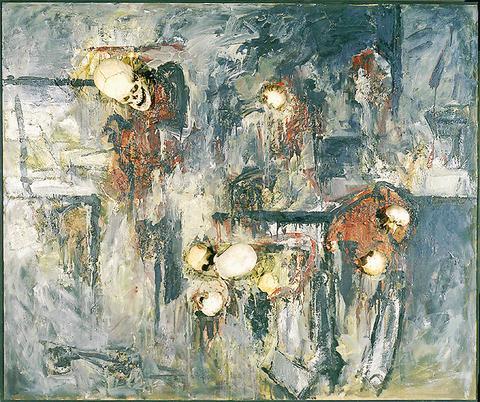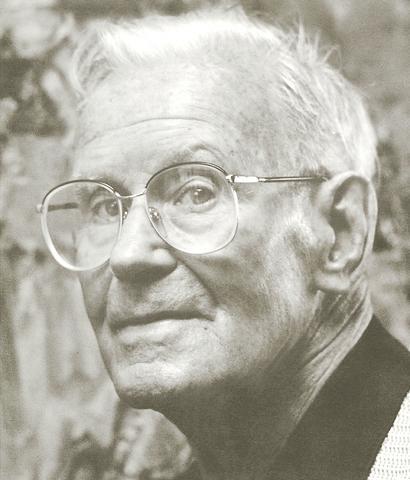It is hard to believe that America has held a war without artist Hans Burkhardt being around to shock the conscience, perhaps with a signature painting of black, brooding crosses, blood red background and real human skulls embedded in the canvas.
Swiss-born Burkhardt, who died at the age of 89 in 1994, was an Abstract Expressionist who specialized in symbolically portraying the pain of war, a man whose first major work was inspired by the Nazi bombing of Guernica in the Spanish Civil War, a subject more famously chosen by Picasso.
While living in the sunny, even bucolic Hollywood Hills, where he had emigrated in the 1930s, Burkhardt went from painting the atrocities of the Spanish Civil War to painting other battles and cataclysmic events: World War II, the unleashing of the atomic bomb, the Korean conflict, Vietnam, El Salvador and Operation Desert Storm.

PHOTO: REUTERS
A friend and student of New York City abstract master Arshile Gorky, Burkhardt was an odd duck as far as California painters go -- a man grimly wrestling with the devil while others concentrated on happier, lighter subjects such as cheerful red, white and blue American flags for example.
By contrast, Burkhardt's American flags are painted in blacks and greys with blood dripping from them.
And ultimately, Burkhardt was also a pretty well forgotten man by gallery goers though not by critics who came to value him more and more as the years passed.

But as America managed its brief war in Iraq and its even longer occupation, Burkhardt's long-time friend, Los Angeles gallery owner Jack Rutberg, thought it was time to mount a retrospective and remind viewers that the past is but prologue to the present.
Following footsteps
So up on the walls of his spacious gallery in Los Angeles' Fairfax District went 50 large canvases done by the man described by the late art historian Eugene Anderson as "Goya's spiritual heir."
The exhibition, which was to close in September, was extended through October, and has won some renewed critical attention for Burckhardt plus spirited discussions at the gallery.
Rutberg said one by-product of the show was a decision by the Los Angeles County Museum of Art (LACMA) to rehang in its permanent collection a Burkhardt it had taken down in 1945 amid complaints that the painter's use of deep reds made him a communist sympathiser.
(He always maintained he was non-political although he once attacked Ronald Reagan through his work when Reagan was president of the Screen Actors Guild. One 1945 painting called Studio Scab, Ronald Reagan shows a deformed figure standing in a corner clutching a bag of money.)
With many of the nation's poets, writers and artists vying with each other for new ways to condemn the Iraq war and occupation, some are finding a kindred spirit in Burckhardt.
During the Vietnam War, he embedded skulls into the surface of his paintings in what the art historian Peter Selz called "extending the art of assemblage to an apotheosis." Another critic, Donald Kuspit, said Burkhardt's images were "among the greatest war paintings."
The skulls were first embedded in giant 1966 and 1969 protest pieces, Lang Vei, My Lai and Last Judgment, Dark Shadows, the Burial of My Enemies.
Rutberg said the skulls came from Burkhardt's time as an artist living in Mexico in the early 1950s.
"In Mexico at that time, if you didn't pay for the grave, they dug you out and left your bones on the ground. Hans would be in the graveyards painting when he would see the skulls just lying about, sometimes even people playing soccer with them.
Images of skulls
"He felt he would love to have some to draw from and never intended to put them in his paintings. But years later he was so deeply moved by the Vietnam War, he put them into his work and broke new territory. The skull is the most charged image in Western culture."
Skulls were not the only objects that Burkhardt placed in his paintings. His last series, called Black Rain and dealing with feelings of his own mortality as well as atrocities in the guerrilla war in El Salvador, used bits of charred wood installed in them, forming crosses along with a sculpted head of Christ he had found in Mexico.
"Personally he was far from being a bleak man," said Rutberg. "In fact, he could not have been more cheery and often he would paint celebrations, lovers, nudes. But he said he had to paint war as well."
Burkhardt once explained his work this way: "The need to lend a voice to suffering is a condition of truth."

“Why does Taiwan identity decline?”a group of researchers lead by University of Nevada political scientist Austin Wang (王宏恩) asked in a recent paper. After all, it is not difficult to explain the rise in Taiwanese identity after the early 1990s. But no model predicted its decline during the 2016-2018 period, they say. After testing various alternative explanations, Wang et al argue that the fall-off in Taiwanese identity during that period is related to voter hedging based on the performance of the Democratic Progressive Party (DPP). Since the DPP is perceived as the guardian of Taiwan identity, when it performs well,

The Taiwan People’s Party (TPP) on May 18 held a rally in Taichung to mark the anniversary of President William Lai’s (賴清德) inauguration on May 20. The title of the rally could be loosely translated to “May 18 recall fraudulent goods” (518退貨ㄌㄨㄚˋ!). Unlike in English, where the terms are the same, “recall” (退貨) in this context refers to product recalls due to damaged, defective or fraudulent merchandise, not the political recalls (罷免) currently dominating the headlines. I attended the rally to determine if the impression was correct that the TPP under party Chairman Huang Kuo-Chang (黃國昌) had little of a

At Computex 2025, Nvidia CEO Jensen Huang (黃仁勳) urged the government to subsidize AI. “All schools in Taiwan must integrate AI into their curricula,” he declared. A few months earlier, he said, “If I were a student today, I’d immediately start using tools like ChatGPT, Gemini Pro and Grok to learn, write and accelerate my thinking.” Huang sees the AI-bullet train leaving the station. And as one of its drivers, he’s worried about youth not getting on board — bad for their careers, and bad for his workforce. As a semiconductor supply-chain powerhouse and AI hub wannabe, Taiwan is seeing

Jade Mountain (玉山) — Taiwan’s highest peak — is the ultimate goal for those attempting a through-hike of the Mountains to Sea National Greenway (山海圳國家綠道), and that’s precisely where we’re headed in this final installment of a quartet of articles covering the Greenway. Picking up the trail at the Tsou tribal villages of Dabang and Tefuye, it’s worth stocking up on provisions before setting off, since — aside from the scant offerings available on the mountain’s Dongpu Lodge (東埔山莊) and Paiyun Lodge’s (排雲山莊) meal service — there’s nowhere to get food from here on out. TEFUYE HISTORIC TRAIL The journey recommences with